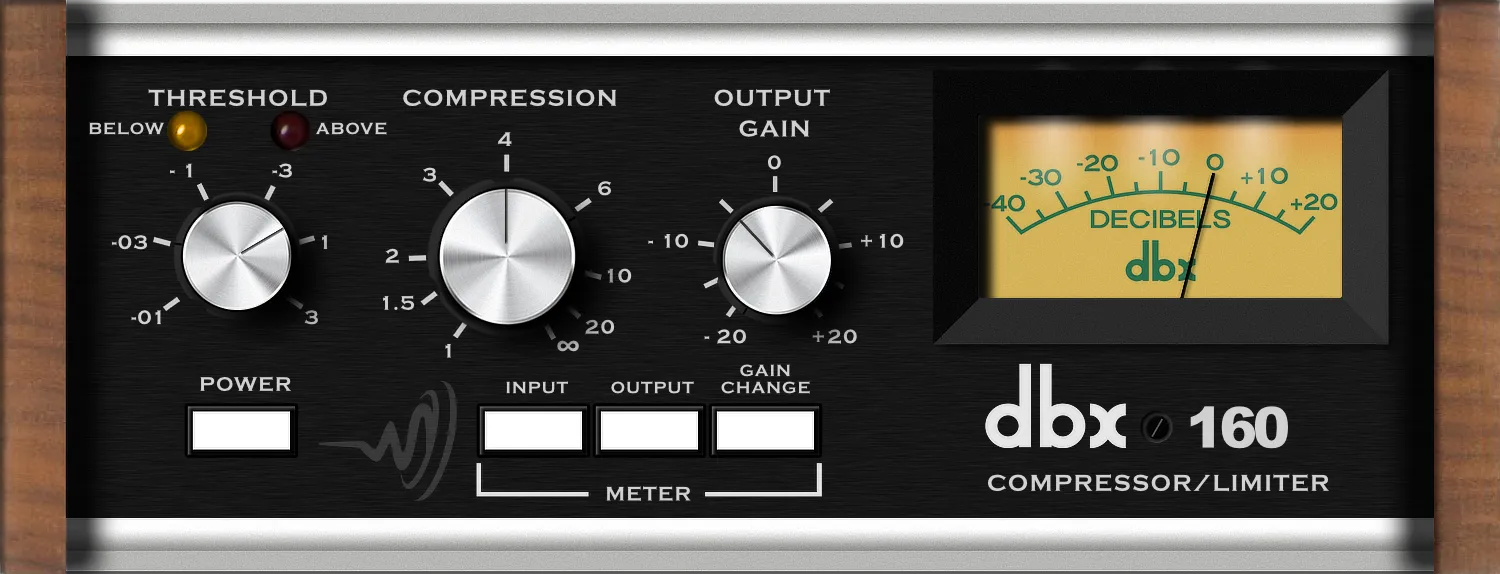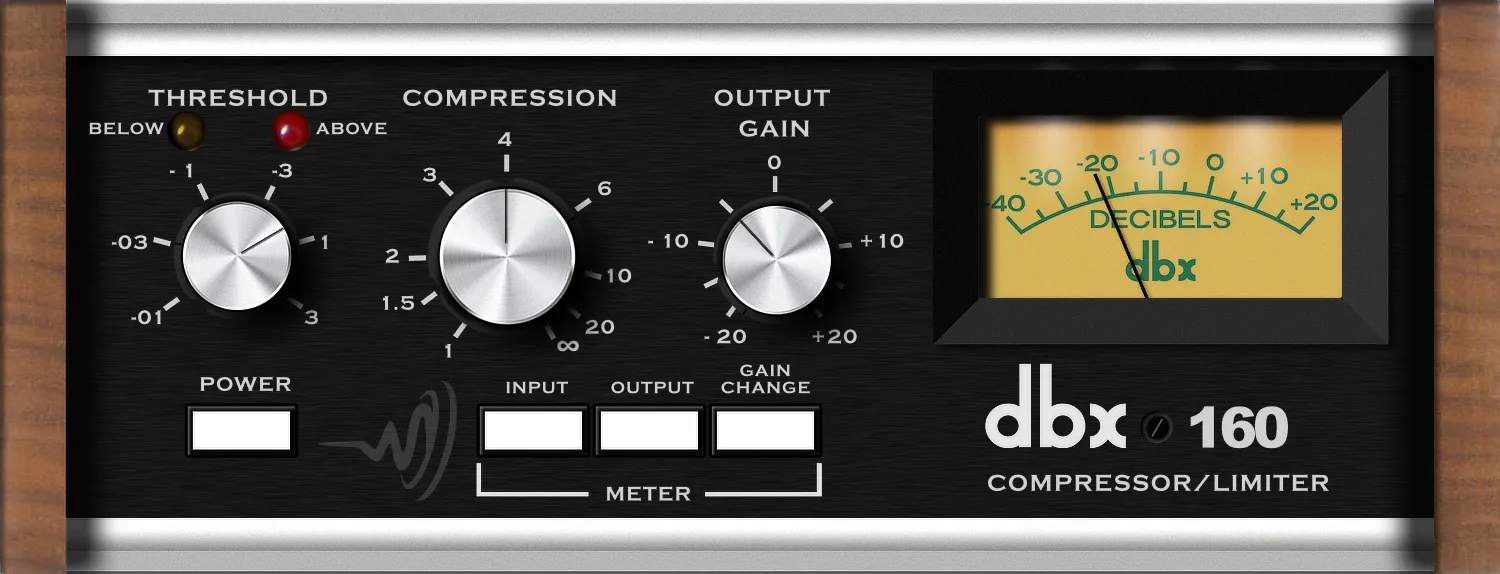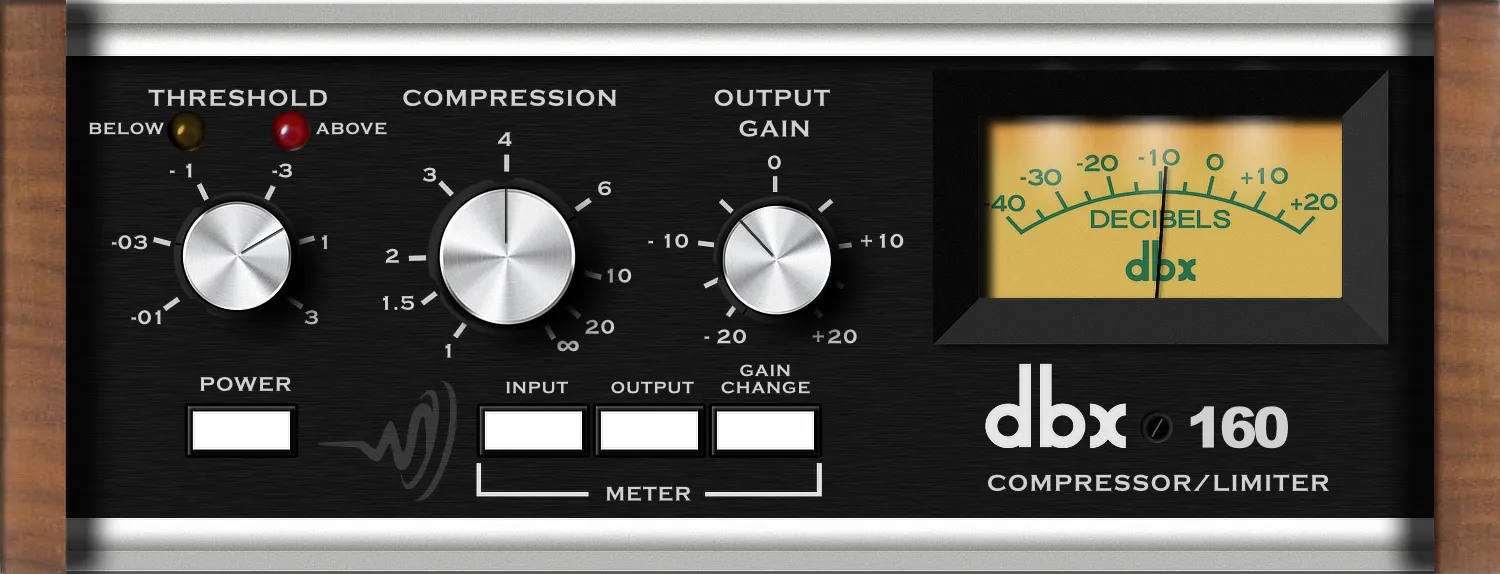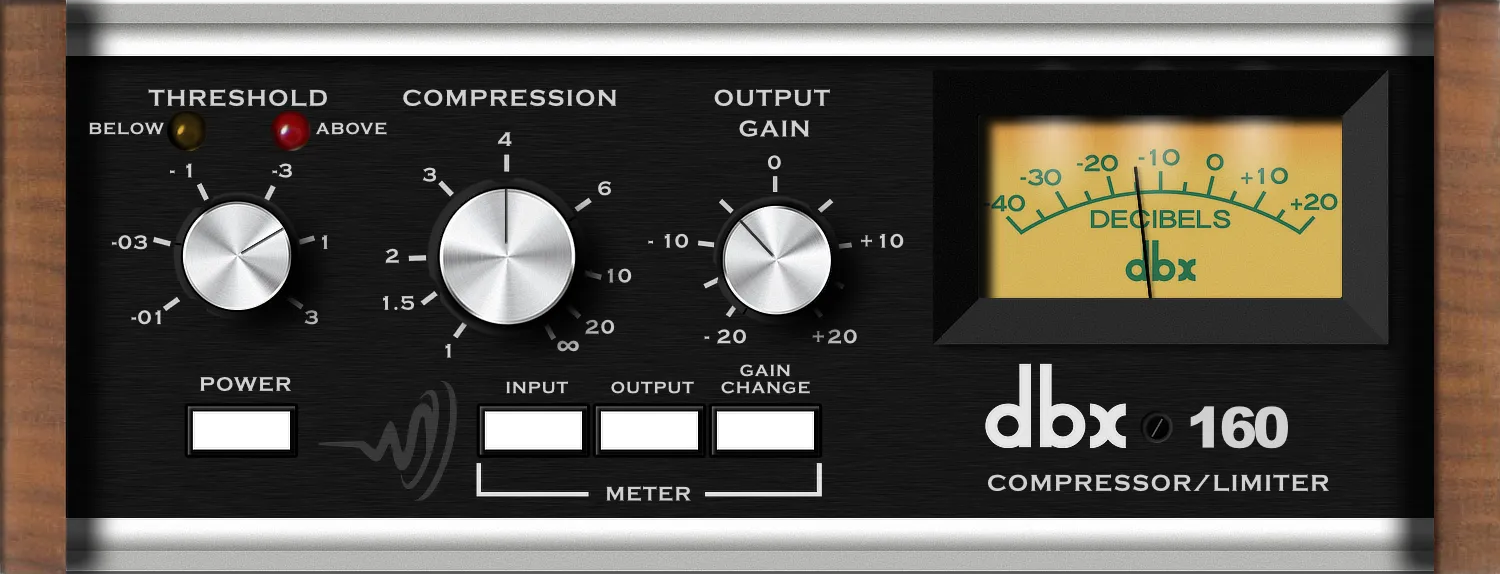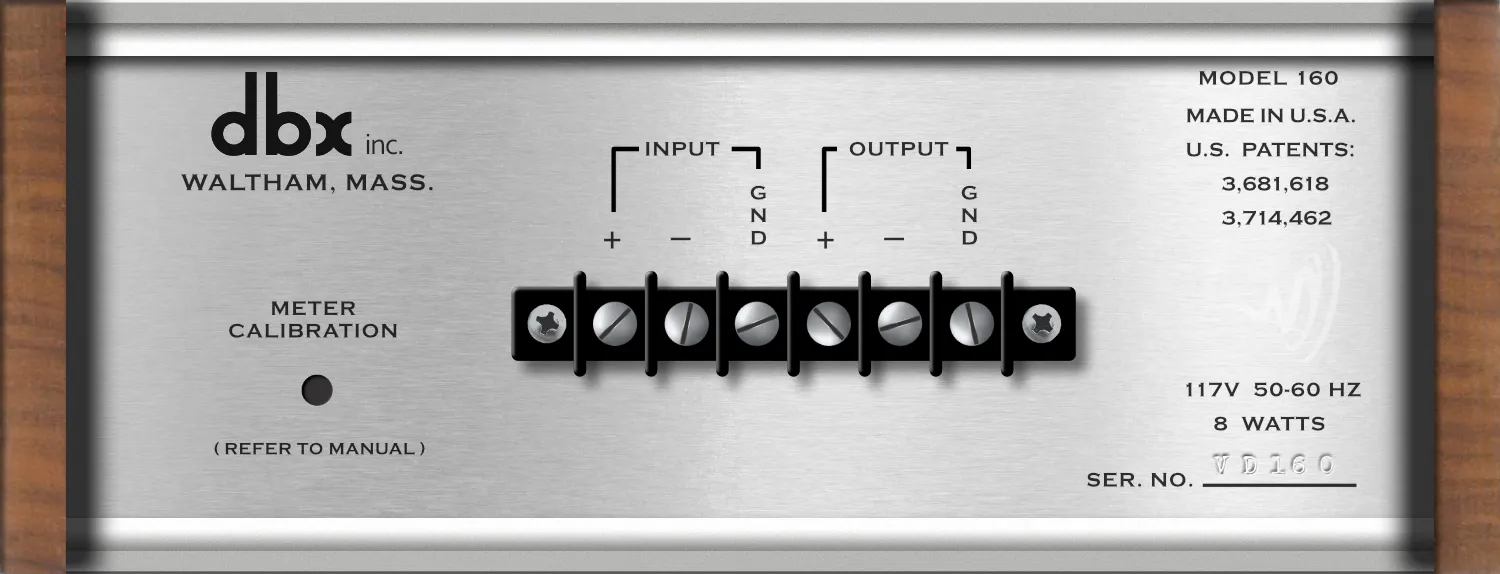The dbx technique of true rms level-detection gives you audible benefits. Most compressor/limiters use some form of peak detection, with fast response characteristics that can have a disturbing effect on program material. True rms level detection closely simulates the response of the human ear. Even at high compression ratios, the gain changing action of the dbx 160 is highly listenable and natural sounding.
Because of the unique feed-forward approach, dbx 160 and dbx 161 limiters can achieve infinite compression with complete stability and inaudible distortion. The dbx approach is quite unlike gain reduction in a conventional compressor/limiter. Traditional gain reduction is accomplished by sensing signal level at the device’s output and applying a correction signal, via a feedback loop.
At progressively higher compression ratios, the feedback loop’s gain increases, distortion increases, and eventually instability or oscillation occurs. To avoid this problem, many conventional units restrict the maximum amount of feedback, thus restricting the maximum compression ratio to some lower ratio, such as 10:1 or 20:1. The dbx 160 Compressor/Limiter and 161 are free of the instability of excessive loop gain and can provide infinite compression (approximately 120:1).
In addition to increasing the stability and the available range of compression, dbx’s feed-forward approach on the dbx 160 makes it possible for the attack and release times to “track” the signal envelope. In conventional compressor/limiters, the attack and release times depend on feedback loop gain, which means they constantly must be readjusted for optimum results at different compression ratios. Since the attack and release times of dbx units vary automatically with the rate of level change in the program material (the envelope shape), operation is simplified; no manual attack/ release adjustments are required. At the same time, the ‘naturalness” of any given sound is better preserved.
dbx noise reduction systems now make it possible to process programs with 100dB, or greater, dynamic range. Unfortunately, in some applications it is necessary to restrict dynamic range. While dbx noise reduction systems are used in the studio, for record production, to maintain wide dynamic range, this range must often be restricted to optimise the sound for broadcast and home playback.
The restriction of dynamic range is usually done with a compressor, in the final stages of recording (or record mastering). In the broadcast field, where many stations compete for an audience, a high average audio level can make a big difference to radio station ratings. Compression is used to attain high average levels. However, unless a high-quality compressor/limiter is utilised, distortion and unwanted audible side-effects may degrade the sound so badly that the advantages of high average level are overcome, and audience interest can be lost. The dbx 160 Compressor/Limiter and 161 do a great job in both recording and broadcast applications.
The dynamic range of a live musical performance can be even greater than 100dB. A high-quality compressor/limiter, used judiciously, can restrict the dynamic range, raise the average level, help the operator avoid clipping distortion, and improve the overall sound quality. Because the 160 and 161 sound so natural, they won’t displease performers, making them especially well-suited to sound reinforcement applications.
Compressor/limiters can be useful in other applications too. The 160 and 161 are ideal for use as a high-quality line amplifier because of their low noise and distortion and high output drive. The 160 and 161 have the added advantage of allowing you to conveniently dial in compression at any time. In any application requiring high-quality compression or limiting the dbx 160 and 161 provide superior performance at a reasonable price.
Some compressor/limiters have jacks that ostensibly equip the units for stereo operation. The jacks “strap” the gain control sections of the two single-channel units together so that the stereo image remains stable even when the signal level is radically different in the two channels. dbx’s Model 160 and 161, are not equipped for stereo operation. The lack of “strapping” provisions is no over-sight; it is a well thought out engineering decision. The reason for this decision is simple, if not immediately obvious.
Stereo tracking between two separate dbx 160 compressor/limiters require great accuracy. This tracking accuracy has little to do with the quality or the ability of a single-channel unit to meet its specifications. Even with better than average component tolerances, component-to-component variation is typically 10%; most potentiometers have 20% tolerances. Such tolerances are perfectly acceptable and will not degrade the performance of an individual single-channel unit. Internal trimmers are adjusted to provide any needed correction, and any critical components are matched or have precision tolerances.
While the front panel settings of two “strapped” units may be identical, component tolerances can cause the actual performance to vary from unit to unit by as much as 20%. Even small tolerance differences will cause the stereo image to shift rapidly from right to left. These normal component tolerances only become a problem if two units are strapped together for stereo operation.
If any given pair of single-channel units ever manufactured could be strapped together for accurate stereo tracking, individual component tolerances in each unit would have to be very tightly controlled. This approach would not improve the performance of any one single- channel unit, but it would make the cost of all units prohibitive.
There are three other ways to build compressors with stereo strapping jacks: (The easy way out) Put in the jacks on production units that are not critically matched, and ignore the resulting problems: (The expensive way out) install highly accurate, precision components throughout the compressor for accurate stereo tracking performance, and charge every purchaser for the stereo capability, whether or not it is needed, or (The hard way out for you) install enough external trim-pots so that, if you had the right test equipment, you could adjust the tracking accuracy yourself … as often as required by component aging or touring abuse.
None of the above solutions were very palatable to dbx (nor would the results have been to you, the user). dbx decided that omitting the stereo tracking feature would improve the overall value of the product and would help dbx to keep its commitment to product excellence at reasonable cost. There is no reason for people who need a single-channel compressor/limiter to pay for precision parts or matching that they do not need. Neither is there any reason for someone who needs a stereo compressor/limiter to accept inferior performance from units with strapping jacks but no matched or precision components that would provide precise stereo tracking accuracy.
Instead, dbx decided to offer another model, the dbx 162, which is a two-channel compressor/limiter designed and built for the user who needs precise stereo tracking. The 162 utilises matched components and close-tolerance parts to achieve precise tracking, with easy, single-knob adjustments. The 162 does the job at an attractive price. It makes a lot of sense when you think about it: a precise dbx compressor/limiter for single-channel jobs, and another for precise stereo operation.
Models – The dbx 160 is a fully professional compressor/limiter with a balanced differential input, with an automatic ground-loop compensated output (hum resulting from any ground loop at the output is automatically sensed and attenuated at least 40dB), and with a special protection circuit that blocks power turn-on and turn-off transients from the output.
The dbx 161 is nearly the same as the dbx 160, but is priced for the smaller studio, or the semi-pro user. It has the same advanced rms detection and feed-forward circuitry as Model 160, but it lacks turn-on/turn-off transient protection, and ground-loop compensation. The 161 ‘s input and output are unbalanced and terminated in RCA-type phono jacks.
Both models have adjustable threshold, and a pair of LEDs that indicate when the input level is above or below the threshold. An illuminated meter displays a full 60dB range and is switchable to read input level, output level, or gain change. The meter’s sensitivity is continuously variable, so “zero VU” can be adjusted to equal your system’s nominal operating level, anywhere from +10 to -10dB. Output line level is also adjustable, ±20dB. Maximum output on the 160 is +26dB (15.5V) into a high impedance, or +24dBm (12.3V) into 600 ohms. Maximum output on the Model 161 is +18dB (6.14V) into a high impedance, or +16dBm (4.89V) into 600 ohms.
Attractively styled and functionally designed, either model can stand alone or can be mounted in a standard 19″ rack. Two units can be mounted side-by-side in just of panel space with the optional dbx RM-150-C rack mount RM-150-D is for rack mounting of a single unit.

